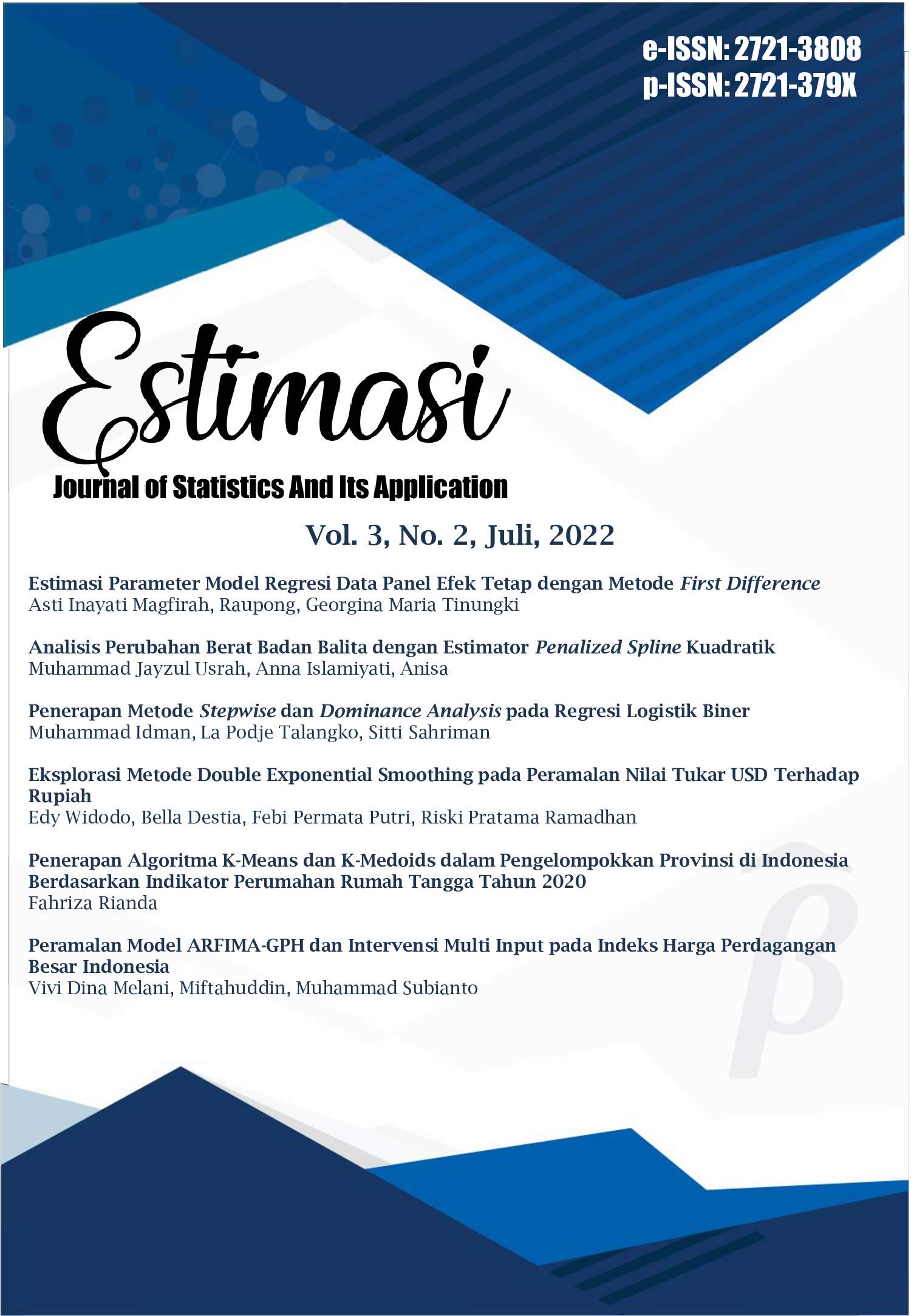Penerapan Algoritma K-Means dan K-Medoids dalam Pengelompokan Provinsi di Indonesia Berdasarkan Indikator Perumahan Rumah Tangga Tahun 2020
DOI:
https://doi.org/10.20956/ejsa.vi.19100Keywords:
Best Algorithm Selection, , Household Housing Indicators, k-means, k-medoidsAbstract
Statistics Indonesia explained that the percentage of households in Indonesia that had access to decent, safe and affordable housing during the 2019-2020 period was still below 60 percent. Of course, this is a big job for the government to be able to achieve the target in the RPJMN 2020-2024, which is up to 70 percent in providing decent, safe, and affordable housing for the community by 2024. This study aims to group provinces in Indonesia based on indicators. household housing by applying and choosing the best algorithm among k-means and k-medoids. Based on the selection of the best algorithm, k-means is the best algorithm in classifying provinces in Indonesia compared to k-medoids with three clusters. The results of the grouping of provinces in Indonesia are expected to assist the government in dealing with problems related to household housing indicators so that the government's target of increasing the percentage of households occupying decent, safe, and affordable housing can be achieved.
References
PUPR, “Program Sejuta Rumah Per Juli Capai 515.107 Unit,” 16 Agustus 2021. [Online]. Available: https://perumahan.pu.go.id/news/program-sejuta-rumah-per-juli-capai-515107-unit.
Kompas.com, “Pemerintah Targetkan 11 Juta Rumah Tangga Tempati Rumah Layak Huni hingga 2024,” 1 Juli 2021. [Online]. Available: https://www.kompas.com/properti/read/2021/07/01/060000721/pemerintah-targetkan-11-juta-rumah-tangga-tempati-rumah-layak-huni.
BPS, Statistik Perumahan dan Permukiman 2019, Jakarta: BPS, 2020.
PPDPP, “Di Tengah Pandemi COVID-19, Realisasi Program Sejuta Rumah TA 2020 Capai 965.217 Unit,” 8 Januari 2021. [Online]. Available: https://ppdpp.id/di-tengah-pandemi-covid-19-realisasi-program-sejuta-rumah-ta-2020-capai-965-217-unit/.
BPS, “Persentase Rumah Tangga yang Memiliki Akses Terhadap Hunian Yang Layak Dan Terjangkau Menurut Daerah Tempat Tinggal (Persen), 2018-2020,” 26 Januari 2021. [Online]. Available: https://www.bps.go.id/indicator/29/1242/1/persentase-rumah-tangga-yang-memiliki-akses-terhadap-hunian-yang-layak-dan-terjangkau-menurut-daerah-tempat-tinggal.html.
W. Wijayanti, I. Rahmi dan F. Yanuar, “Penggunaan Metode Fuzzy C-Means Untuk Pengelompokan Provinsi di Indonesia Berdasarkan Indikator Kesehatan Lingkungan,” Jurnal Matematika UNAND, vol. 10, no. 1, pp. 129-136, 2021.
V. A. Latuhimallo, M. W. Talakua dan Z. A. Leleury, “Analisis Clustering Untuk Pengelompokan Kabupaten/Kota Berdasarkan Indikator Kesejahteraan Rakyat di Wilayah Provinsi Maluku,” Jurnal Matematika, Statistika dan Terapannya, vol. 2, no. 1, pp. 127-138, 2021.
BPS, Indikator Perumahan dan Kesehatan Lingkungan 2020, Jakarta: BPS, 2020.
E. Prasetyo, Data Mining Mengolah Data Menjadi Informasi Menggunakan MATLAB, Gresik: Penerbit ANDI, 2013.
D. Jollyta, W. Ramdhan dan M. Zarlis, Konsep Data Mining dan Penerapan, Pekanbaru: deepublish, 2020.
Suyanto, Data Mining Untuk Klasifikasi dan Klasterisasi Data Edisi Revisi, Bandung: INFORMATIKA, 2019.
B. Wira, A. E. Budianto dan A. S. Wiguna, “Implementasi Metode K-Medoids Clustering Untuk Mengetahui Pola Pemilihan Program Studi Mahasiswa Baru Tahun 2018 di Universitas Kanjuruhan Malang,” Jurnal Terapan Sains & Teknologi, vol. 1, no. 3, pp. 54-69, 2019.
J. Han, M. Kamber dan J. Pei, Data Mining Concepts and Techniques Third Edition, Waltham: Elsevier Inc., 2012.
A. Kassambara, Practical Guide To Cluster Analysis in R, sthda.com, 2017.
A. C. Benabdellah, A. Benghabrit dan I. Bouhaddou, “A Survey of Clustering Algorithms For an Industrial Context,” Procedia Computer Science, vol. 148, no. 2019, pp. 291-302, 2019.
D. N. Gujarati dan D. C. Porter, Basic Econometrics Fifth Edition, New York: The McGraw-Hill Companies, 2009.
Downloads
Published
Versions
- 2022-07-02 (3)
- 2022-07-02 (2)
- 2022-07-01 (1)
Issue
Section
License
Copyright
It is the author's responsibility to ensure that his or her submitted work does not infringe any existing copyright. Authors should obtain permission to reproduce or adapt copyrighted material and provide evidence of approval upon submitting the final version of a manuscript.


